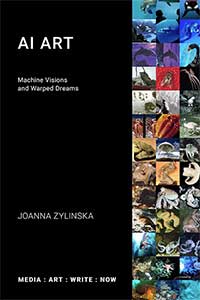
|
FreeComputerBooks.com
Links to Free Computer, Mathematics, Technical Books all over the World
|
|
- Title: AI Art: Machine Visions and Warped Dreams
- Author(s) Joanna Zylinska
- Publisher: Springer; 2020 edition; eBook (Creative Commons Licensed)
- License(s): Creative Commons License (CC)
- Paperback: 129 pages
- eBook: PDF (178 pages)
- Language: English
- ISBN-10: 1785420852
- ISBN-13: 978-1785420856
- Share This:

|
Can computers be creative? Is algorithmic art just a form of Candy Crush? Cutting through the smoke and mirrors surrounding computation, robotics and artificial intelligence, Joanna Zylinska argues that, to understand the promise of AI for the creative fields, we must not confine ourselves solely to the realm of aesthetics. Instead, we need to address the role and position of the human in the current technical setup – including the associated issues of labour, robotisation and, last but not least, extinction.
The book critically examines artworks that use AI, be it in the form of visual style transfer, algorithmic experiment or critical commentary. It also engages with their predecessors, including robotic art and net art.
About the Authors- Joanna Zylinska is a writer, lecturer, artist, curator, and – according to the ImageNet Roulette's algorithm – a ‘mediatrix’. She is currently Professor of New Media and Communications at Goldsmiths, University of London.
- Artificial Intelligence and Logic Programming
- Computer and Machine Vision
- Art, Music, and Related
- Miscellaneous and Uncategorized Books
 Similar Books:
Similar Books:
-
 Art Intelligence: How Generative AI Relates to Human Art-Making
Art Intelligence: How Generative AI Relates to Human Art-Making
What impact will Generative AI (GenAI) have on how we create art and how we understand what art is for? How will it affect the role of the artist in the future and the conditions under which artists will work?
-
 Computational Formalism: Art History and Machine Learning
Computational Formalism: Art History and Machine Learning
How the use of machine learning to analyze art images has revived formalism in art history, presenting a golden opportunity for art historians and computer scientists to learn from one another.
-
 Understanding New Media Art (Elizabeth Bilyeu, et al)
Understanding New Media Art (Elizabeth Bilyeu, et al)
This is an introductory college art and art history courses that builds on scholarship in the field to propose a long historical context for the technologies and ideas related to New Media Art in the 21st century.
-
 Art History and Machine Learning (Amanda Wasielewski)
Art History and Machine Learning (Amanda Wasielewski)
How the use of machine learning to analyze art images has revived formalism in art history, presenting a golden opportunity for art historians and computer scientists to learn from one another.
-
 Exploratory Programming for the Arts and Humanities
Exploratory Programming for the Arts and Humanities
This book introduces programming to readers involved with the arts and humanities; there are no prerequisites, and no previous knowledge of programming is assumed. It reveals programming can also be a tool for sketching, brainstorming, and inquiry.
-
 The Limits of Art (Jiri Benovsky)
The Limits of Art (Jiri Benovsky)
This open access book is about exploring interesting borderline cases of art. It discusses the cases of gustatory and olfactory artworks, proprioceptive artworks, intellectual artworks, as well as the vague limits between painting and photography.
-
 From ASCII Art to Comic Sans: Typography in the Digital Age
From ASCII Art to Comic Sans: Typography in the Digital Age
Offers an original vision of the history of typography and computing in the digital age, viewed through the lens of offbeat typography - shows how text is always an image that conveys meaning, and how typography has shaped modern visual and material culture.
-
 Modeling Creativity - Case Studies in Python (Tom De Smedt)
Modeling Creativity - Case Studies in Python (Tom De Smedt)
This book is to model creativity using computational approaches in Python. The aim is to construct computer models that exhibit creativity in an artistic context, that is, that are capable of generating or evaluating an artwork (visual or linguistic), etc.





